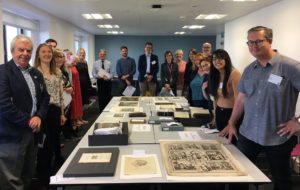Following on from our first workshop meeting in Vancouver in March, in September, we collaborated with the research team at Wellcome Collection to explore sound in the archives from a global, theoretical and historical perspective. Wellcome houses an exceptional collection of early modern rare books, manuscripts, prints and art works, and this gave us a unique opportunity to discuss how we might engage with historic sounds through exploring the material residues of sound in text and image. Richard Williams, an ethnomusicologist specialising in Mughal India, opened the workshop by leading a session that examined a selection of Wellcome’s Hindi manuscripts. Wellcome Collection holds approximately 650 Hindi manuscripts, though little work has been done on them except for Peter Friedlander’s A descriptive catalogue of Hindi manuscripts in the Library of the Wellcome Institute for the History of Medicine (1996). Most of these manuscripts were collected from 1911 until 1939 and unlike many archives, which hold ‘clean’ collector copies, many of Wellcome Collection’s manuscripts show signs of how they were read and used. Being able to see and handle the materials that Williams discussed enabled us to consider book production, manuscript circulation and sounds in India.
Williams began by outlining how Francesca Orsini’s insights into multilingualism have informed his critical thinking about listening for the trace of sound: a reader of a Hindi text can listen for traces of the other languages in use in this multilingual society. In considering this insight at a sonic level, Williams addressed how working with sound enabled us to tease out how these texts were heard. Drawing from François J Bonnet’s work on trace, Williams encouraged us to think more carefully about how we excavate the trace of the sound – the point when the sonorous becomes perceptible and traceable – instead of focusing upon the sound itself. These traces of sonic practices and listening in Classical Hindi also contain the traces of intellectual thought in Classical Hindi, challenging how we think about sound in western languages and cultures.
These insights raised questions as to what ‘early modern’ means in a global context. As Williams noted, some of the manuscripts we were examining dated to the nineteenth century. A number of scholars who work on early modern India refer to overlaps in intellectual culture between the continuation of practices well-established since the seventeenth century and concepts and languages that are explicitly modern. Manuscript production continued well into the twentieth century in India and print did not become mainstream until around 1800, demonstrating an intense relationship between the text and how performance elements are inflected in the text by the way in which the reader/singer has transcribed their copy. Since music tends not to be notated before the nineteenth century, musicians relied upon Rāga, a system that provided a framework for improvisation, making it difficult to find the authentic sound, but Wellcome’s well-loved collection offers clues about the traces of sound in the archive.

Williams then went on to observe how visual paintings represent Rāga and how training in listening to poetry and music enabled the listeners to visualise sound into a highly theorised poetic language. Williams took us through several examples of these stylised and beautiful images in Wellcome’s archive, raising questions about how we listen to and visualise music. The first Music treatise in Hindi dates to 1504 and forms part of Wellcome’s collection. The lack of pictorial representation suggests that the manuscript is unfinished but it still offers multiple ways of thinking about sound. Collectively, these texts enable scholars to piece together (and draw conclusions on) how sound was conceived and understood in Mughal India.
The session ended with a discussion on a Sexological herbal and how many treatments for sexual disease included treating the voice because the voice is required for seduction. The herbal listed various herbs that enabled the person who swallowed them to ‘sing like a celestial angel’. This put me in mind of texts such as Thomas Cogan’s The Haven of helthe (1584), which advises its reader to ingest balls made from honey and mustard seed before breakfast to clear their chest and improve their voice. As well as being a wonderful opportunity to explore beautiful manuscripts, I found this session particularly insightful for considering not only the points of departure between Eastern and Western ways of thinking about sound, but also potential points of crossover. It highlighted the necessity of interdisciplinary conversations to gain a nuanced appreciation of listening and hearing in the early modern period.
The first of our panel sessions, ‘Archives of Sound and Hearing’ began with Louise Marshall, a lecturer at University of the Arts London and a recent post-doctoral secondee to the research team at Wellcome Collection. Approaching sound as someone who works in sound arts and on sonic meaning, Marshall discussed ‘Reverb: how contemporary sonic theory can resonate the past’. Marshall began by examining The Piccadilly Nuisance (1818), and how this etching creates a sonic environment. With the caveat that there is the obvious lack of audible sonic material to work with, Marshall commented upon the challenges that sound presents us with when we think about it as a historically-situated form. In turning to the sensory, Marshall highlighted the need to listen in different ways to understand ‘noisy objects’ – a term used by Elma Brenner, one of the research team’s medieval and early modern specialists, to illustrate how sound can be captured on the page.
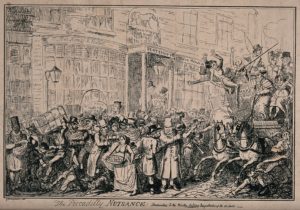

In considering how we might adapt and hear the sounds of the past, Marshall explored the effect of sound upon material culture, bodily affect, the continual referencing backwards of sound, sonic politics, and the differences between hearing and listening. In this physiological process, hearing comes before listening: sound is not simply sound, but a process that describes relationships and positionality. Taking particular noisy objects as case studies, Marshall explored how these images present a soundscape and how the insights of Murray Schafer and Rachel Carston, read together, enable us to have a much deeper sonorous map where sound is not only a collection of sounds, but is also related to its close cousin noise. Marshall encouraged us to consider the sounds that are ‘out of place’ and not just the sounds that are meant to be articulated.
Finally, Marshall considered awe and the space of Notre Dame Cathedral offered a particularly potent case study, perhaps especially in light of the recent fire that devastated the building. Marshall observed how sound happens in the space around us and spaces shape our experiences of sound, and her insights resonated with discussions we had at our Vancouver workshop. In addressing the raw materials used in building work, Marshall outlined scholarship that had explored how the higher frequencies heard in York Minister had been affected by the fire that gutted its south transept in 1984. Noting that these historic buildings are sites of destruction and regeneration, Marshall highlighted how, regardless of the historical time period, we need to consider both the link between personal sound and our sonic identity, and sound on a social level. Marshall concluded by underscoring the importance of sonic interaction and how, instead of thinking of sound, we could think about the sonorous.
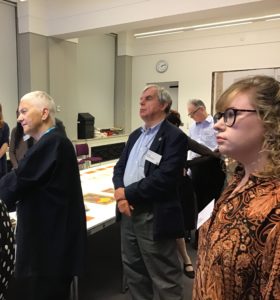 Marshall’s detailed paper thus traversed pictorial representation, sonic space in buildings, sound affects on the body, and what challenges are presented when we consider these sounds historically. The archive as a repository of sound and text is central to these concerns and also informed Jennifer Richards’ paper, ‘Animating Texts and a Wellcome Collection Case Study’. This paper was partly an academic discussion and partly a pitch for collaborative work that Richards had been undertaking with Wellcome and with colleagues at Newcastle University. Here, Richards examined the relationship between rare book repositories and digital archives and called for new approaches to digitising rare books which consider the relationship between digital archives, print, and the human voice. Her insights not only presented us with ways of understanding rare books, but also pointed to how the books of the future could extend the book’s design and the book’s relationship with the digital.
Marshall’s detailed paper thus traversed pictorial representation, sonic space in buildings, sound affects on the body, and what challenges are presented when we consider these sounds historically. The archive as a repository of sound and text is central to these concerns and also informed Jennifer Richards’ paper, ‘Animating Texts and a Wellcome Collection Case Study’. This paper was partly an academic discussion and partly a pitch for collaborative work that Richards had been undertaking with Wellcome and with colleagues at Newcastle University. Here, Richards examined the relationship between rare book repositories and digital archives and called for new approaches to digitising rare books which consider the relationship between digital archives, print, and the human voice. Her insights not only presented us with ways of understanding rare books, but also pointed to how the books of the future could extend the book’s design and the book’s relationship with the digital.
Richards is an authority on the history of rhetoric and her most recent scholarship has focused upon the human voice as an important technology for understanding book production and book reading. The voice-aware author understands how a reader can change the meaning of words, and Richards hypothesised how recognising this possibility might change how we interact with the book and the sound of the books of the future. In considering the future of book production, Richards is also keenly aware of the ways voice informed rare books: voice exercises used in the Tudor classroom lie behind the soundscapes of a text and, through digital technologies, Richards and her collaborators have been examining how meaning is made with the voice. Through these technologies, we might be able to search a book for mood, tone and voice, enabling readers to record their own readings and to show how creativity is introduced by tonal variation. Richards’ insights brought alive the sixteenth-century book, illustrating how they are not only objects that can be held in the hand or stored on the bookshelf, but contain information that is read, processed, interpreted and understood.
The book, thus, in Richards’ reading is an immersive, multidimensional object and a repository of sound where the potentiality of voice lies waiting to be heard. In the final paper of this panel, ‘beyond notation: early modern manuscripts as repositories of sound’, Thomas Schmidt considered how the sonic experience is archived. Notation is a memory aid that attempts to recreate the ‘real’ music as it is manifested in sound. Sound is archived and recorded through descriptions of musical events, the visual and physical evidence of sound as illustrated by the musical instrument upon which music is played, and in the evidence of the notated sources themselves. The focus of Schmidt’s paper was the book as an object of use in performance as he addressed how they might serve as archives of sound beyond their notation. Paying particular attention to the size and the layout of the music book, Schmidt examined patterns of use – how paying attention to the material elements of the book can tell us about how they are sounded and used in the world. Printed table books place musicians in a different spatial configuration in comparison to part books or choir books, affecting the ways in which musicians and listeners interact with sound and how they make music with (and at) each other. What came through from Schmidt’s paper was how the sonic experience is a closed one and particular modes of book production demand musicians interact with them in specific ways, leading to different forms of sonorous presentation. Schmidt concluded by exploring how the size of the book might be relative to the sound and the book’s function and use. The spatiality of sound is not only governed by the spaces in which it is heard, but also from the book from which the sound is notated. A symbiotic relationship thus emerges, where sound, book, content and surrounding spaces all contribute to the sonic experience.
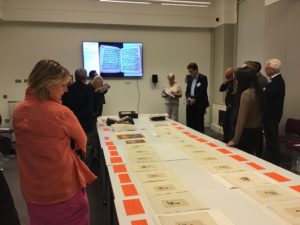 The first day thus highlighted the importance of attending to the noisy object of the book and the sonic environments in which it was used. These strands continued into the second day, where the second panel, on the traces of sound opened with a paper by Catriona Cooper, an archaeologist specialising in sound modelling and the work she has been doing as part of the Listening to the Commons project. Her paper, ‘modelling the ephermeral: the case of the nineteenth-century House of Commons’ outlined how acoustic modelling technologies could be used to reimagine the sonic environments of spaces that no longer exist. Through recourse to archival evidence such as architectural plans, we can begin to rebuild ephemeral spaces. Although we can never fully recreate the past, digital modelling can provide us with a sense of how the ‘lost’ space might have sounded. Cooper’s insights helped us to address difficult questions relating to audibility and authenticity and how these spaces could be modelled so that interaction is less ‘passive’, enabling us to gain a clearer sense of the lived experience of spaces that no longer exist.
The first day thus highlighted the importance of attending to the noisy object of the book and the sonic environments in which it was used. These strands continued into the second day, where the second panel, on the traces of sound opened with a paper by Catriona Cooper, an archaeologist specialising in sound modelling and the work she has been doing as part of the Listening to the Commons project. Her paper, ‘modelling the ephermeral: the case of the nineteenth-century House of Commons’ outlined how acoustic modelling technologies could be used to reimagine the sonic environments of spaces that no longer exist. Through recourse to archival evidence such as architectural plans, we can begin to rebuild ephemeral spaces. Although we can never fully recreate the past, digital modelling can provide us with a sense of how the ‘lost’ space might have sounded. Cooper’s insights helped us to address difficult questions relating to audibility and authenticity and how these spaces could be modelled so that interaction is less ‘passive’, enabling us to gain a clearer sense of the lived experience of spaces that no longer exist.
Following on from Cooper’s insightful discussion of how we can use the archive to trace architectural space and model the sounds that were experienced within these spaces, Katherine Butler Schofield, in her paper ‘Chasing Eurydice: Music and its Material Traces in seventeenth and eighteenth century Mughal India’, began with a discussion of spatiality of the throne in the Diwan-i-Aam pavilion inside the Red Fort complex in Old Delhi, built during the reign of Mughal emperor Shahjahan (ruled CE 1628-58). This ornate marble throne was intended for public audiences, where the emperor would listen to the grievances of his subjects. Curiously, and unusually for Islamic architecture, figurative art decorates the throne: one scene depicts Orpheus, raising questions as to the purpose of this decontextualized Greek mythology and what this might imply about the relationship between sound and governance. Sound, for Jains, is auspicious and cleanses the space: this is represented in art and architecture through a chain and bell motif, which was later repurposed in Islamic architecture. Illustrating the auspiciousness of sound, Schofield continued her discussions by noting the noise, sound, bustle and joy of Indian genre painting, developing and building upon Richard Williams and Louise Marshall’s insights from the previous day.
The final paper of this panel was given by Simon Smith on ‘Song in the archive: the case of playhouse music’. Here, Smith considered the traces of sound that can be found in English drama before the closing of the playhouses at the outbreak of civil war in 1642. Early modern music manuscripts and printed collections offer limited information on how music, perhaps especially dance, was performed in the playhouse. To augment and extend our understanding of musical production, Smith proposed that we question the dramatic function of music in a play and how its non-theatrical afterlife as a playtext leaves archival traces of its status as a performance piece. Taking Thomas Dekker, John Ford, Thomas Middleton and William Rowley’s The Spanish Gypsie (pub. 1653) as a case study, Smith explored how the dramatic production of song and its later circulation illustrated music’s capacity to relay meaning across various different contexts and how specific tunes ask for particular modes of performance.
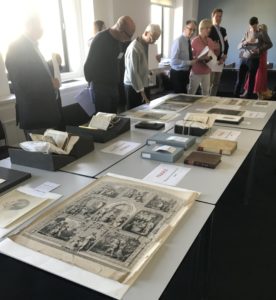 In the final session, Julia Nurse, Angela McShane and William Schupbach led a curated showcase, presenting us with their own interpretations of the collections. In this session, we interrogated Wellcome’s unique collections through the multilayered potential of ‘sound’, including hearing, listening, tone, deafness and gesture, and the complex connections between sight and sound. Charles Butler’s The feminine monarchy, or, the history of bees (first printed, 1609) is the first major manual on beekeeping in the English language. The second edition contains a four-part madrigal where Butler attempts to notate and recreate the sounds made by a queen bee. This book not only gave us an insight into how Butler attempted to engage with the sounds of the natural world, but also presented us with a madrigal printed to enable the parts to be performed around a table: the ecology of the beehive connected to the spatiality of the domestic space in which the music would be performed. Other notated forms on display included a setting of music by Corelli to a drinking song, illustrating how music can be repurposed for different (sometimes satirical) contexts. Nurse also commented upon the materiality of the book itself by discussing how waste music scores are recycled in the binding of later books.
In the final session, Julia Nurse, Angela McShane and William Schupbach led a curated showcase, presenting us with their own interpretations of the collections. In this session, we interrogated Wellcome’s unique collections through the multilayered potential of ‘sound’, including hearing, listening, tone, deafness and gesture, and the complex connections between sight and sound. Charles Butler’s The feminine monarchy, or, the history of bees (first printed, 1609) is the first major manual on beekeeping in the English language. The second edition contains a four-part madrigal where Butler attempts to notate and recreate the sounds made by a queen bee. This book not only gave us an insight into how Butler attempted to engage with the sounds of the natural world, but also presented us with a madrigal printed to enable the parts to be performed around a table: the ecology of the beehive connected to the spatiality of the domestic space in which the music would be performed. Other notated forms on display included a setting of music by Corelli to a drinking song, illustrating how music can be repurposed for different (sometimes satirical) contexts. Nurse also commented upon the materiality of the book itself by discussing how waste music scores are recycled in the binding of later books.
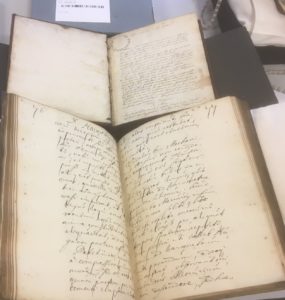
Following on from considering musical notation, the next items exhibited were images of sound and silence. From noisy streets to a cobbler downing tools and the face of a boy listening to Christ, these images captured the gestures and sensations of listening, hearing and interacting with sound. These noisy and noiseless objects also embodied how sensory experience differs according to the auditor’s capacity to hear: texts such as John Buwler’s Philocophus, or, the deafe and dumbe mans friend (1648) illustrate how deafness and ways of communicating were understood and essays on echoes and the speaking trumpet, designed to carry the voice, highlight how sound could be amplified. Among the many fascinating objects that surfaced for the collections workshop were two sets of lecture-notes in Latin, taken by different auditors who heard Boerhaave’s lecture on hearing. These lectures notes could make for a fascinating case study regarding how utterances are listened to and transcribed, including what is (mis)heard and (mis)remembered when we are attentive to the spoken word and we would like to commission further work on these texts. The workshop ended with a discussion on how sound tropes might be represented. Schupbach detailed Friedrich Schiller’s poem, The Song of the Bell (1798), which depicts the making of a bell, the bell in the stages of human life, and the role of the bell in society. In closing his remarks, Schupbach commented upon how the ephemeral becomes durable through replication. This observation was an insightful point to end on, as it is central to the role of the archive as a repository of sound. When we handle materials in the archive, we are examining them in a different context to how they were first read, used, and disseminated. This creates new contexts for the noisy objects as they are handed down and passed on. Through listening to the traces of sound in the archives, we can gain insights into how the ephemeral becomes durable and the various contexts in which the textual and visual utterances on the page form part of the sonic environment. It is imperative to keep in mind these observations and the role of silence on the soundscape as we prepare for our next workshop which will centre upon sound, the body, and emotion.
